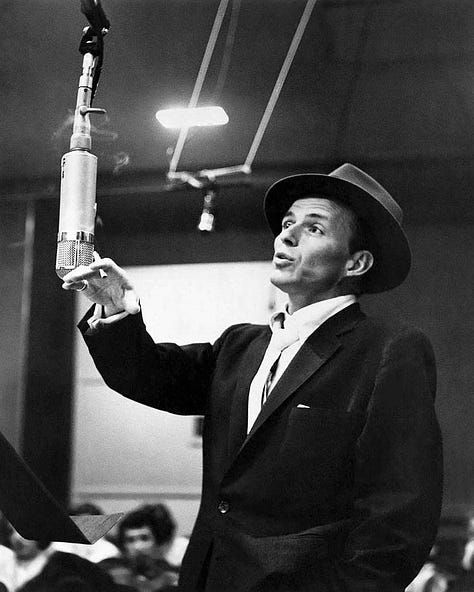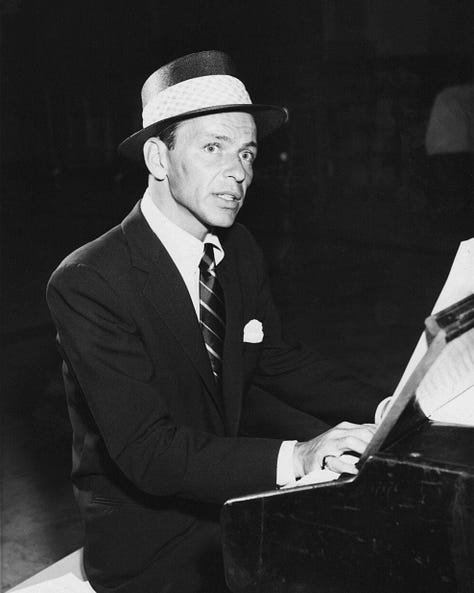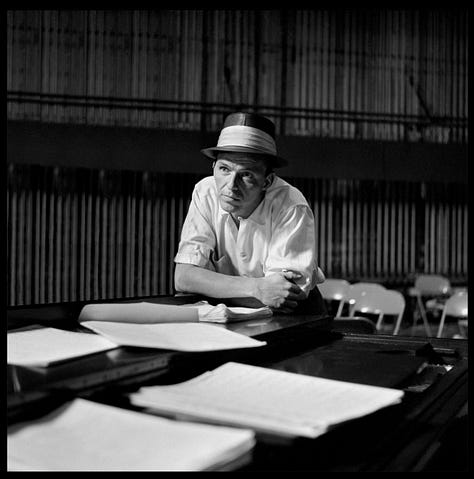Frank Sinatra Lurks In The Wee Small Hours Of The Morning
A golden voice, a moody masterpiece, and the first album of the pop era.
This article is part of our archive series. It was first published in October of 2023. This version has been lightly edited and updated for clarity.
Listening to Frank Sinatra is to have someone sing a conversation in your direction. His was the most pure and golden male voice in the history of recorded Western music, and he was always delivering something more than just a song.
That’s the true genius of Sinatra and his voice; He was telling the story to YOU.
1955 America was littered with velvet voiced band singers, but there was only one Frank Sinatra. Tony Bennett, Bing Crosby, Al Martino, and a host of others lined up to join the chorus but even the finest of them paled in comparison with Old Blue Eyes.
Sinatra had been fronting bands, releasing hit records and even starring in Hollywood hits for two decades by the mid-50’s. After the end of World War Two, Sinatra saw a dip in his popularity. The teen audience with whom he had won such huge successes had eschewed Sinatra, largely for the new world of rock and roll.
Entering his late 30’s Sinatra had grown bored of playing the teen idol anyway. His first marriage had hit the skids, and it appeared he might be over the hill before even hitting age 40. Francis Albert Sinatra had hit a bona fide slump, baby. For the first time in his career, success did not arrive with ease and immediacy.
Despite significant pressure from within the A&R Department at Capitol Records, Alan Livingston - the VP of the label - signed Sinatra to a seven year recording deal in the spring of 1953. The gamble paid off immediately.
Later that same year, Sinatra was nominated for and later won Best Supporting Actor for his role in From Here To Eternity. Sinatra was back on the upswing once again, and a new musical partnership was about to blossom.
Capitol paired Sinatra with staff conductor Nelson Riddle for his initial releases on the label. In January of 1954, the first release of the new partnership was released as Songs For Young Lovers. Before the summer was out, Capitol would release a second set of Sinatra/Riddle collaborations under the moniker Swing Easy.
The records were both hugely successful, and Sinatra’s career was once again riding high. He was a hit at the box office, on the bandstand and had even earned the acclaim of his peers with an Oscar. Out of the spotlight however, things were not so rosy.
Actress Ava Gardner and Sinatra were reaching the end of their tempestuous relationship. The Hollywood “It” couple were the talk of the town with both Sinatra and Gardner partaking in open affairs. As the relationship came to a final close - they would not officially divorce until 1957 - Sinatra was lonely, depressed and looking for something more meaningful within his work.
He hunted for songs written on the themes of loneliness, depression, loss, and regret. After selecting a host of options, he took them to Riddle and began to lay out his vision.
The entire album would be built around the very idea of loneliness. Instead of choosing songs at random or for their possible commercial appeal, Sinatra sought to create a serious work with deep intention and meaning.
Taking the idea to Capitol, Sinatra explained that he wanted the record to be taken seriously by the music press and audiences as well. He wanted to avoid releasing the album on the conventional pop format of 10” records. Instead, he wanted to use the 12” LP format that was the typical format choice for classical music, the “serious” sound of the era.



This format change would add an air of respectability to the next Sinatra album. It would also allow Sinatra and Riddle to release more than the usual seven or eight tracks that typically fit onto two sides of a ten inch record. At that time, albums on 10” vinyl were also usually comprised of songs that had been previously released as singles with perhaps an additional filler song or two.
For the initial release, Capitol was willing to press the album as a double 10” record set. This would allow Sinatra to include all of the tracks he planned to record for the album. It would not provide him with the air of serious work he had hoped for. Still, he and Riddle pressed ahead.
They whittled Sinatra’s song selections down to 15 tunes that Riddle would adapt for the themes of Sinatra’s vision. By slowing the pace of Hoagie Carmichael’s ‘I Get Along Without You Very Well’, Riddle’s strings pull the ache from the song. What had been previously recorded as a clever novelty song was now transformed into a bleeding elegy to a lost love.
Riddle’s running strings throughout ‘When Your Lover Has Gone’ dance with the velvet bass tones of Sinatra’s open notes. Splashy muted trumpets on ‘Mood Indigo’ sound like traffic in the rain. The musical conversations behind the voice are vast and verdant sonic, asphalt jungles.
Cole Porter’s ‘What Is This Thing Called Love?’ begins with hopeful woodwinds, but my mid-tune is drenched in minor strings sending Sinatra to the Heavens looking for answers, and hope. He finds neither.
From there, the second half of the album droops into maudlin introspection. Aching orchestration and the painful sweetness of Sinatra’s voice meld with hear- wrenching song selections like ‘Last Night When We Were Young’ and ‘I’ll Be Around’. In the latter number, Sinatra sings, “I’ll be around ‘til he’s gone.” He is resigned to his fate of lonely late night walks, wondering what might have been.
In addition to the 15 standards, Sinatra commissioned a new song based on the themes of the album. Riddle returned with a new tune by David Mann and Bob Hilliard. The pair had written the tune for Sinatra in the midst of a late night session. It was perfect.
‘In The Wee Small Hours Of The Morning’ begins with a moaning violin section and a bell chiming the notes of the refrain. The sound is eerie, unsure, calm, and foreboding.
Then, Sinatra begins to sing, ‘In the wee small hours of the morning, while the whole wide world is fast asleep.’
In a sentence and just a few seconds of orchestration, a thesis statement is delivered. What follows is the first true album of the pop music era. It’s also the first concept record, such as we know it. Before Sgt. Pepper or Exile On Main Street or Tommy, there was In The Wee Small Hours Of The Morning.
The cover was an original commission as well. Eschewing the typical approach of a buoyant cover photo of a smiling Frank splashed with colorful text and eye-catching graphics, Sinatra sought out an original painting designed to visually echo the sonic sentiments held within.
The painting, done by the capital art department, seems drawn from the world of pulp novels and the brush of Edward Hopper. A pensive Sinatra leans against a building as lampposts hazily light an empty, late night street. Smoke trails upwards from a cigarette dangling from his fingers. Much like the songs inside, the album art is moody, distant, and lonely.
By the second pressing, Capitol relented to Sinatra’s wish for a 12” pressing. The record in its new version was once again a smash success. It sold huge numbers, made millions for Capitol, and led the wave for the LP record as the standard format for pop music for the next four decades.
The album was a critical smash, as well as a huge financial success. Nearly 70 years later, it is seen by many as the apex of Sinatra’s recorded output. While it lacks the bombast of later Riddle collaborations, the contemplative nature of the song selections and subdued instrumentation of In The Wee Small Hours Of The Morning stand as a powerful example of how lyric, arrangement and context can elevate a set of songs into something far greater than its itinerate parts.
The Sinatra/Riddle partnership would lead to massive hits like ‘Summer Wind’, ‘The Lady Is A Tramp’, ‘Nice & Easy’ and so many more. As he aged, Sinatra became the showbiz personality version of his most famous songs. The charm of the tunes mentioned above along with the ever-present ‘My Way’ carved the setlist for his later shows.
Yet, for all his recorded work, In The Wee Small Hours Of The Morning stands as the pinnacle of his output to my ears. It seems almost impossible that a man could release his greatest album, change the entire face of popular music, and resurrect his own career all at once, but Sinatra did just that. And then he let the world largely forget that he had done it.
As we exit the album era, the stunning genius of Sinatra’s greatest record has never been more clear. Listening to this slow, deliberate masterwork in the age of streaming is like a peaceful walk in the woods for world weary lovers carrying the remaining chunks of their broken hearts.
With those opening strings, that chime and that golden voice, the album invites us down a dark and rainy street for a walk through the seedy side of love late at night. Sinatra and Riddle guide us along the dampened neighborhoods for the next 49 minutes to deposit us back at the very point where we began.
It will be the same spot where you started, but everything will have changed, thanks to Francis Albert Sinatra.
Cheers,
Matty C











☆☆☆☆☆